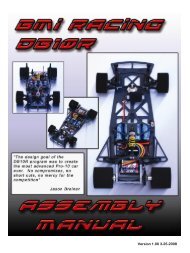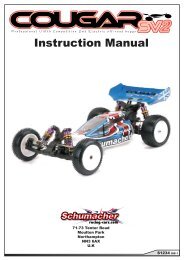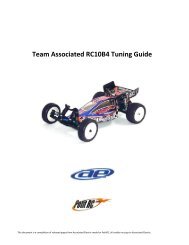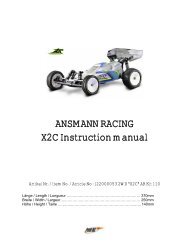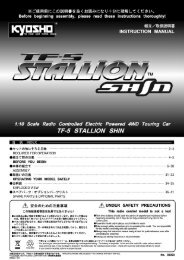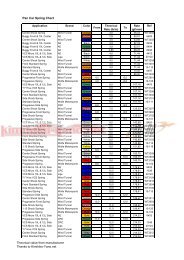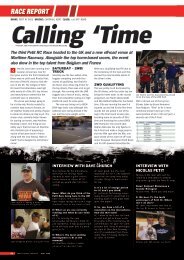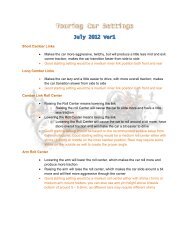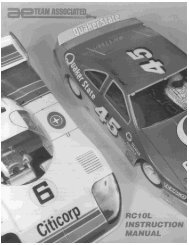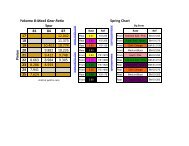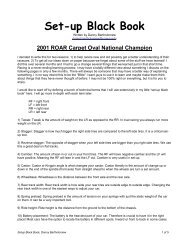XRAY T3 Set-up Book - Petit RC
XRAY T3 Set-up Book - Petit RC
XRAY T3 Set-up Book - Petit RC
You also want an ePaper? Increase the reach of your titles
YUMPU automatically turns print PDFs into web optimized ePapers that Google loves.
BUMP STEER, ACKERMANN<br />
BUMP STEER<br />
Bump steer is an undesirable handling effect that occurs when a car’s front toe<br />
angle changes as its suspension compresses or rebounds, from the position that<br />
was pre-set using a set<strong>up</strong> station.<br />
To reduce or eliminate bump steer, the angle of the steering rods must be changed.<br />
This is easily accomplished by using shims between the outer steering rod ends<br />
and the steering blocks.<br />
Bump steer is a suspension tuning option commonly used in off-road <strong>RC</strong> racing<br />
to change steering characteristics over rough and loose terrain. However, we<br />
strongly recommend eliminating bump steer in touring car suspensions.<br />
1. Make sure the car is fully set <strong>up</strong>, has been de-tweaked, and is “race ready”. Remove the tires and body.<br />
2. Put the car on the set-<strong>up</strong> station.<br />
3. Press down and quickly release the front shock tower to get the suspension to settle.<br />
4. Use the set-<strong>up</strong> stands and the toe-gauge to measure the front toe angle at rest.<br />
5. Press down on the front shock tower until the front of the chassis is approximately 1-2mm above the board. Hold the chassis in place.<br />
6. Use the set-<strong>up</strong> stands and toe-gauge to measure the front toe angle under compression, and see if the front toe angle has changed.<br />
7. If the front toe angle changes when the front suspension is compressed, do the following:<br />
• Add or remove shims underneath the outer steering rod end (in 1mm increments) in 1mm increments<br />
• Repeat steps 5-6 until the front toe is the same with the suspension at rest or compressed.<br />
A barely noticeable change is acceptable, but you may need to use 0.5mm shims to completely eliminate the angle change.<br />
ACKERMANN<br />
Outer<br />
Ackermann<br />
Position<br />
Ackermann controls the difference in steering arcs between the front inside and<br />
outside wheels. The inside wheel always has a tighter arc in any corner. The<br />
amount of grip provided by the tires, in relation to the steering arc and speed<br />
of the car, create an amount of measurement called a “slip angle” for each<br />
wheel. For some tires you need a greater difference in slip angles between the<br />
inner and outer wheel and for some you need less. The size and geometry of the<br />
servo saver on <strong>XRAY</strong> cars forces the inside wheel to increase its turning angle at<br />
a greater rate than the outside wheel, as the servo turns either way from center.<br />
The rate of the increase, called Ackerman effect, can be changed by the angle of<br />
the steering rods connecting the servo saver to the steering blocks. The straighter<br />
the rods are in relation to each other, the more Ackerman effect will be applied<br />
to the inside wheel.<br />
Inner Ackermann Position<br />
Slip angles work differently on each wheel when the car is slowing down & pitching forward, than when the throttle is applied & the tires are pulling<br />
the car forward. The goal in tuning ackerman is to get the car to keep a consistent steering arc after going from off-power to on-power, while not<br />
allowing the front inside wheel to be turned too much and drag through the corners instead of rolling through them. If the car steers well off-power<br />
but pushes on-power, then use more Ackermann effect and decrease your transmitter EPA/dual rate. If the car steers well on-power and pushes<br />
off-power, or if you can hear the front inside wheel chattering at mid-corner, then use less Ackermann effect and increase your transmitter EPA/dual<br />
rate.<br />
The angle of the steering rods can be changed by moving the steering rods inner mount position on the servo saver, or outer mount position on the<br />
steering blocks.<br />
1. Inner Ackermann Position (servo saver) – Changing the forward/rearward position of the servo saver has the greatest Ackermann effect<br />
Position #1 (forward) – less Ackermann effect (steering rods more angled)<br />
Position #2 (rearward) – the greatest Ackermann effect (steering rods straighter)<br />
2. Outer Ackermann Position (steering blocks) – Changing positions on the steering blocks is used to fine tune the Ackermann effect<br />
Position #1 (forward) – more Ackermann effect (steering rods straighter)<br />
Position #2 (rearward) – less Ackermann effect (steering rods more angled)<br />
NOTE: It is recommended to use more Ackermann effect in low-to-medium grip conditions and less Ackermann effect in medium-to-high grip<br />
conditions.<br />
17



